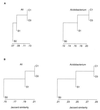Assessment of microbial diversity in four southwestern United States soils by 16S rRNA gene terminal restriction fragment analysis
- PMID: 10877790
- PMCID: PMC92095
- DOI: 10.1128/AEM.66.7.2943-2950.2000
Assessment of microbial diversity in four southwestern United States soils by 16S rRNA gene terminal restriction fragment analysis
Abstract
The ability of terminal restriction fragment (T-RFLP or TRF) profiles of 16S rRNA genes to provide useful information about the relative diversity of complex microbial communities was investigated by comparison with other methods. Four soil communities representing two pinyon rhizosphere and two between-tree (interspace) soil environments were compared by analysis of 16S rRNA gene clone libraries and culture collections (Dunbar et al., Appl. Environ. Microbiol. 65:1662-1669, 1998) and by analysis of 16S rDNA TRF profiles of community DNA. The TRF method was able to differentiate the four communities in a manner consistent with previous comparisons of the communities by analysis of 16S rDNA clone libraries. TRF profiles were not useful for calculating and comparing traditional community richness or evenness values among the four soil environments. Statistics calculated from RsaI, HhaI, HaeIII, and MspI profiles of each community were inconsistent, and the combined data were not significantly different between samples. The detection sensitivity of the method was tested. In standard PCRs, a seeded population comprising 0.1 to 1% of the total community could be detected. The combined results demonstrate that TRF analysis is an excellent method for rapidly comparing the relationships between bacterial communities in environmental samples. However, for highly complex communities, the method appears unable to provide classical measures of relative community diversity.
Figures




References
-
- Avaniss-Aghajani E, Jones K, Chapman D, Brunk C. A molecular technique for identification of bacteria using small subunit ribosomal RNA sequences. BioTechniques. 1994;17:144–149. - PubMed
-
- Chapin F S, Walker B H, Hobbs R J, Hooper D U, Lawton J H, Sala O E, Tilman D. Biotic control over the functioning of ecosystems. Science. 1997;277:500–504.
-
- Chin K J, Lukow T, Stubner S, Conrad R. Structure and function of the methanogenic archaeal community in stable cellulose-degrading enrichment cultures at two different temperatures (15° and 30°C) FEMS Microbiol Ecol. 1999;30:313–326. - PubMed
Publication types
MeSH terms
Substances
LinkOut - more resources
Full Text Sources
Other Literature Sources

